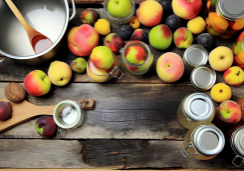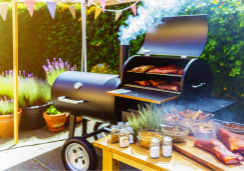Beginner's Guide to Home-Smoked Meats
You might think that smoking meats at home is a complex task best left to the pitmasters, but with the right guidance, you'll find it's quite manageable and even enjoyable.
As you embark on this savory journey, you'll learn how to select the perfect smoker that fits your lifestyle and budget, and you'll discover the secrets to preparing your meats so that they're infused with flavor and tenderness.
The art of smoking isn't just about patience; it's about mastering the techniques that elevate a simple cut of meat to an exquisite culinary experience. From understanding the subtle nuances of different woods and their flavors to maintaining the ideal temperature for that perfect smoke ring, you're about to unlock a world of gastronomic delights.
Stick with me, and soon you'll be serving up delectable, home-smoked creations that could very well become the talk of the town.
Selecting Your Smoker
When embarking on your home-smoking journey, choosing the right smoker is a critical decision that'll shape the flavor and success of your culinary exploits. The type of smoker you select must align with your taste preferences and lifestyle.
If precision and convenience are what you're after, electric smokers offer a 'set it and forget it' approach, ideal for those with busy schedules. Pellet grills, on the other hand, combine the ease of electric smokers with the rich taste of wood-smoked meat, using compressed wood pellets to infuse flavor.
For the purists who swear by the traditional methods, nothing beats the control and ritual of charcoal and adding wood, be it wood chips for quick bursts of flavor or wood chunks for longer, more sustained smoke. An offset smoker caters to the aficionado, allowing you to stoke the fire without disturbing the cooking chamber, while kettle grills offer versatility for those with limited space.
Don't overlook the gas grill, which, with the addition of a smoker box, can deliver smoked dishes without the full commitment of a dedicated smoker. And for the enthusiast looking for a cult favorite, the Green Egg offers a unique combination of grill, oven, and smoker in one.
Balance your budget with quality, and remember that maintenance and cleanup will keep you smoking for years to come.
Preparing the Meat
Having selected your ideal smoker, it's time to focus on the art of meat preparation, a crucial step in achieving that perfect smoky flavor. The first step is to pick the right type of meat. For a delectable experience, opt for large cuts of meat like brisket or pork butt, which are just begging to be smoked. Chicken, too, can take on a sumptuous smoky character under your attentive care.
As you're preparing the meat, trim away any excessive fat to prevent flare-ups; however, leave a thin fat cap to keep the meat moist during the long cooking process. Crafting a flavorful crust starts with a dry rub – a blend of spices and herbs rubbed onto the meat's surface. This not only seasons your brisket or smoked pork but also forms a tantalizing bark as it cooks.
Don't underestimate the importance of temperature. Allow the meat to shed its chill, bringing it to room temperature before it meets the smoker. This ensures a more even cooking process. And remember, preheat your smoker to the desired temperature to maintain a consistent environment for cooking pork or any meat you've chosen.
With these steps, you're well on your way to mouthwatering, home-smoked meats.
Mastering Smoking Techniques
To elevate your home-smoked meats, mastering a variety of smoking techniques is essential, each with its own nuance and influence on the final flavor and tenderness of your cuts.
Begin with low and slow smoking, a method that allows heat and smoke to caress the meat gently, infusing it with rich flavors while tenderizing it to perfection.
You'll want to select the right wood for smoking; each type contributes a unique profile to your meats.
- Hickory: Imparts a strong, bacon-like flavor, excellent for pork and beef.
- Apple: Offers a sweet, fruity taste that's perfect for poultry and pork.
- Mesquite: Delivers an intense, earthy flavor, ideal for bold meats like brisket.
- Cherry: Provides a mild, sweet smoke, well-suited for all meats.
As you add wood, be sure to keep an eye on the smoking process; maintaining a consistent temperature is key. Use a temperature guide to monitor internal temperature and make adjustments as needed.
Understanding Woods and Flavors
As you refine your smoking techniques, it's crucial to understand how the choice of wood influences the symphony of flavors in your smoked meats. Each type of wood carries its own character, its own essence that it imparts to your culinary creations. When you smoke meat, the wood is more than just a heat source; it's a delicate ingredient that can elevate your dish to new heights.
For robust, earthy undertones, woods like mesquite and hickory are your go-to choices. They infuse a powerful smoke flavor that complements red meats brilliantly. But if you're aiming for something subtler, perhaps a hint of sweetness, then fruit woods such as apple or cherry are your best bet, especially for poultry or pork.
Remember, the best wood for smoking meat isn't just about the smoke flavor; it's about harmony with the meat's natural profile. Wood Pellets are particularly suitable for smokers and pellet smokers, offering a consistent, clean burn for low-temperature smoking that's perfect for coaxing out the nuanced notes of your chosen wood.
Don't hesitate to experiment with flavors. Mix woods, play with different combinations, and find the melody that sings to your palate. Your journey with smoked meats is as much about discovery as it's about technique.
Maintaining Temperature Control
Mastering the art of temperature control is pivotal in the alchemy of home-smoked meats, ensuring that the slow dance of heat and smoke transforms your cuts into succulent masterpieces. You'll want to maintain low and slow cooking to imbue your meats with that desired smoky flavor and tender texture. Typically, you're aiming for a temperature range between 200 and 250 degrees Fahrenheit within your cooking chamber.
To maintain temperature control, especially on a charcoal grill, you have to be both vigilant and patient. Here's what you need to keep a close eye on:
- Ambient Temperature: Weather conditions can affect your grill's heat. On a chilly day, you may need more fuel to keep the fire going.
- Ventilation: Proper airflow is crucial. Adjust vents to regulate the temperature.
- Lid Discipline: Resist the urge to peek. Every time you open the lid, heat escapes.
- Fuel Management: Keep a consistent supply of charcoal or wood to avoid temperature drops.
Consider using a Bluetooth thermometer to remotely monitor your grill's temperature. This tool allows you to watch over the indirect heat without constantly lifting the lid, helping you embrace the quintessential low and slow philosophy without the guesswork.
Frequently Asked Questions
What Is the Easiest Meat to Smoke for a Beginner?
You'll find pork shoulder the easiest to begin with, mastering the basics, temperature control, and wood chip selection to perfect its flavor profile and smoke ring while honing your marinating and dry rub techniques.
How to Smoke Meat for Dummies?
You'll master smoking meat by monitoring temperatures, selecting the right wood, and prepping meat meticulously. Learn brining, develop patience, control temperature, and let meat rest for perfect smoke rings. Keep your smoker clean!
What Kind of Smoker Should a Beginner Get?
You'll want a smoker that balances budget, space, and fuel types. Prioritize temperature control, portability, durability, and easy maintenance. Dig into brand reviews and flavor differences to find your perfect beginner smoker.
How Do You Start a Smoker for Beginners?
To start your smoker, first clean it and position it safely. Choose wood carefully, control temperature meticulously, and manage your fire. Adjust vents for smoke density, and remember to season your smoker before cooking.
Conclusion
You've absorbed the essentials of home-smoked meats—embracing the smoker that suits your style, prepping meats with a master's touch, and honing your smoking techniques.
You now grasp the artistry behind wood flavors and the precision of temperature control. So fire up your smoker, let those rich aromas fill the air, and relish the fruits of your newfound craft.
Your journey to smoky perfection is well underway. Welcome to the impassioned circle of smoking aficionados.










